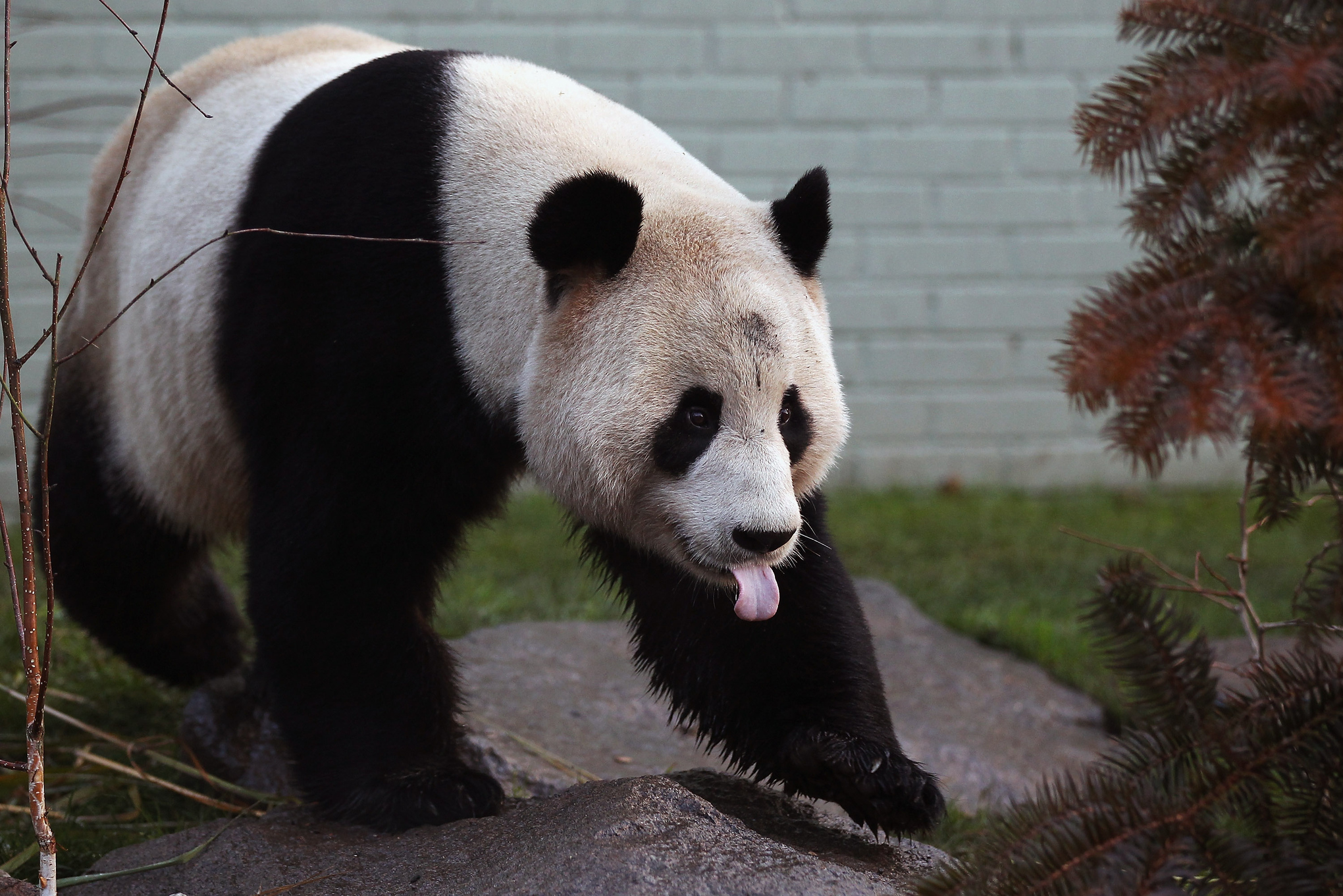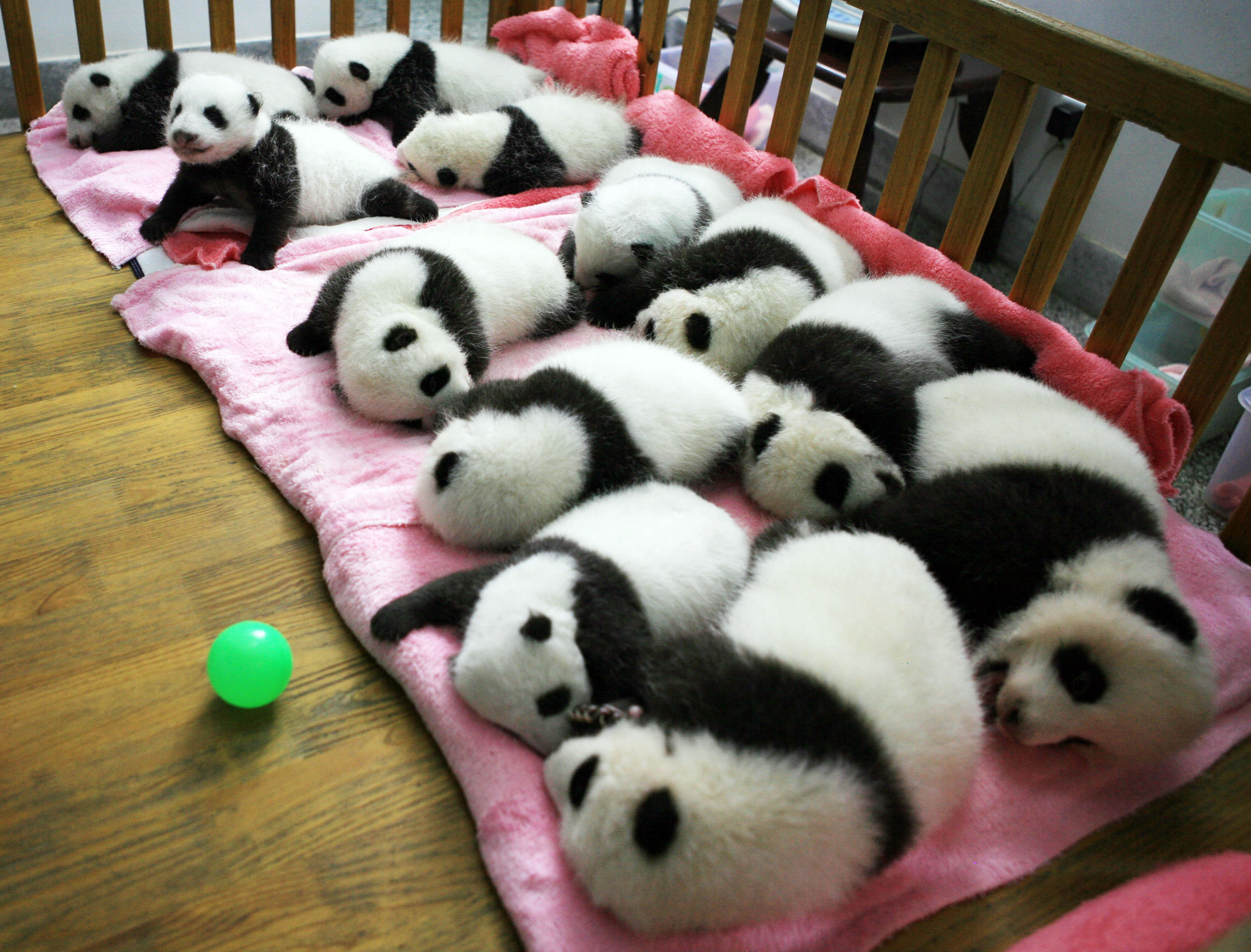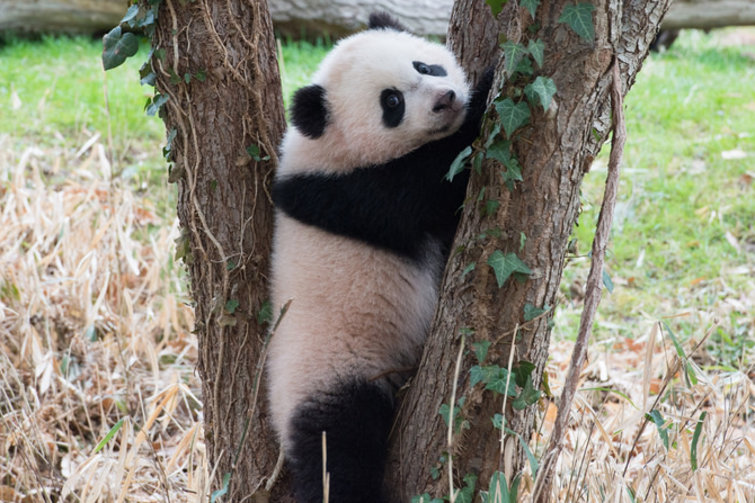
This week, a pair of pandas finally arrived at Kuala Lumpur Airport in Malaysia. The arrival was a long time coming: China had inked a deal with Malaysia to loan a pair of pandas in 2012.
But while the pandas were initially scheduled to arrive in April, China suddenly held off on sending them — as a way to express anger with Malaysia for its handling of the missing Malaysian Airlines flight.
The Malaysian pandas are a perfect symbol of how China’s approaching “panda diplomacy” in the year 2014: using pandas as both a thank-you gift to trade partners, and a bargaining chip when political relations get tense. It wasn’t always this way.

The face of panda diplomacy in Scotland. Jeff J Mitchell/Getty
Kathleen Buckingham, who wrote a paper on panda diplomacy as a student at the University of Oxford, remarks now that “there are pandas all over the world. And there wasn’t always a phase where there’s a new one every week or every month.”
That’s an exaggeration but only barely: in addition to the Malaysian pandas, China sent a pair of pandas to Belgium earlier this spring, and has just signed a deal with Denmark to loan pandas there in the near future.
How China helped change the way the world sees pandas
Unlike other “charismatic megafauna,” pandas are only native to a single country. That gives China much more control over the treatment of pandas than, say, sub-Saharan African countries have over elephants. And it’s used that control to its advantage, encouraging the world to see pandas as, in Buckingham’s words, “the ideal zoo animals.”

Just being the ideal zoo animal. Abby Wood/Smithsonian’s National Zoo
pandas aren’t really “the ideal zoo animals” — but it’s good for china that they’re seen that way
It wasn’t always this way. Late-19th century reports speculated that the panda was mostly carnivorous. And when two of ex-president Teddy Roosevelt’s sons went to the remote jungles of Sichuan in 1928 with the promise of “bagging” a panda — a dead one — they played up the danger of the trip and the elusiveness of their prey, before finally killing a male panda by shooting it in the hindquarters as it walked away.
The Roosevelt boys and others might have overestimated the panda’s ferocity, but not as much as one might expect. One of the pandas raised in the Wolong Reserve in China but released into the wild in recent years was, in Buckingham’s words, “basically beaten to death by wild pandas.”
But captive pandas are still seen as harmless, even lazy. Even in an age when some people are getting anxious about keeping large wild animals in captivity, “it’s not (seen as) cruel to keep an animal in a zoo because it’s so sedate.” And that perception is well-suited to China’s strategy to use zoo pandas for international leverage.
Why we’re in a new age of panda diplomacy
Buckingham and the co-authors of her paper divide modern panda diplomacy into three distinct phases.
Under Mao, pandas were given as goodwill gifts to allies like Russia. But after they were put on the endangered species list in 1984, “you couldn’t just go around giving pandas for good relationships,” Buckingham says.

The cradle of panda diplomacy. STR/AFP/Getty
So China shifted to what Buckingham and others call a “rent-a-panda” strategy: loaning pandas to foreign zoos in exchange for a fee of $50,000 per panda per month. This helped raise revenues for China, and reflected a national shift toward free-market economic policies under Deng Xiaoping’s “open door policy,” but it, too, violated conservation agreements (and looked a little tacky). It was ultimately replaced with long-term loans of pandas, with fees going in part to conservation efforts.
after the 2008 earthquake destroyed panda habitat, sending them abroad looked more attractive
The third phase of panda diplomacy, which started in the late 2000s, isn’t marked by how pandas are loaned, but by how many. In 2008, an earthquake destroyed much of pandas’ habitat within China: 67% of wild pandas’ habitat was affected, and all 60 of the pandas being held in the Wolong Reserve had to find temporary foster homes. Suddenly, sending pandas abroad, for money and goodwill, became a more attractive option for China.
The year before the earthquake, 11 international zoos had pandas on loan; as of 2014, 18 zoos have loaned pandas, and two more have signed agreements to receive pandas in the near future.
What China wants in return: the carrot…
When the Chinese government started the current wave of panda loans, Buckingham and her coauthors discovered a pattern: pandas were sent to trade partners shortly after major trade agreements were signed, as a way of expressing a desire to build a long-term trade relationship.
When they first submitted their theory as a paper in 2011, Buckingham says, it was rejected as “conjecture.” But in the next year or so, new panda deals fulfilled the predictions she and her coauthors had made: “the strong trading partners, basically.”

San Diego-born panda Mei Sheng demonstrates the use of carrots in panda diplomacy. Y Galindo/Zoological Society of San Diego/Getty
That explains the rush to give pandas to Singapore and Malaysia after the ASEAN-China Free Trade Agreement was signed (and to give Thailand an extension on the pandas it already had). It also explains recent loans to France and Australia — both major players in the nuclear industry — as China seeks to expand its own nuclear power capacity.
china uses panda loans and trade deals to exert political pressure
The choice of which zoos get pandas within a country is important, too. The pandas loaned to the United Kingdom, for example, don’t live in the London Zoo, which would be the logical place for them — they were sent to the Edinburgh Zoo, as an acknowledgment of $4 billion in trade deals for exporting Scottish salmon and Land Rovers to China.
But China also uses panda loans (as well as the trade deals themselves) to exert political pressure on countries. China turned to Scotland for its salmon imports, for example, as a replacement for longtime salmon supplier Norway. After the Nobel Peace Prize committee gave the award to Chinese dissident Liu Xiaobo, China took its salmon money somewhere else. Sometimes economics and politics intersect: the panda loan China and Denmark agreed to just last month could be seen as an expression of Chinese interest in Greenland’s natural resources, or as a reward for Denmark walking back its support of Tibetan independence five years ago.
…and the (bamboo) stick
China’s making longer panda loans now than they used to — the loan to Belgium, whose pandas arrived this spring, is 15 years long — and tends to extend the loans before they expire. But just as politics inflect when China gives out pandas, it’s also a factor in when they’re taken away.
did china take a panda from the national zoo in retaliation for obama meeting the dalai lama?
Case in point: the “repatriation” of US-born panda Tai Shan (nee Butterstick) from the National Zoo in 2010, the only time China has ever permanently repatriated pandas in the modern era. Only a few days before Tai Shan was taken to China, the Chinese government had warned President Obama not to meet with the Dalai Lama on a diplomatic visit — and threatened that it would strain US-China relations if he did. The meeting happened anyway. Many panda-diplomacy experts believe that Tai Shan was taken to China in retaliation — as a reminder to the American government that the most popular animal in its own zoo was only there thanks to Chinese generosity.
Buckingham and her coauthors see this as a cautionary tale to governments with loaned pandas: if your guests become too popular with the public, you might find yourself pressured to agree to Chinese demands. After all, Buckingham points out, pandas “speak to the public” in a way most diplomatic concerns don’t.

Bao Bao: a diplomatic incident waiting to happen? Connor Mallon/Smithsonian National Zoo
Which raises the question of new National Zoo panda (and current Washington obsession) Bao Bao, born in 2013. Is Bao Bao going to meet the same fate as Tai Shan — or will the American government be more cautious with China as Bao Bao approaches her 4th birthday than they were with her older brother? Buckingham won’t speculate, beyond saying that it “will be interesting.” But the more attached America gets to Bao Bao while she’s in this country, the more important she’ll be as a diplomatic pawn.
http://www.vox.com/2014/5/23/5742002/panda-diplomacy-china-soft-power-kathleen-buckingham-malaysia-panda-loan?utm_content=buffer435e2&utm_medium=social&utm_source=twitter.com&utm_campaign=buffer








